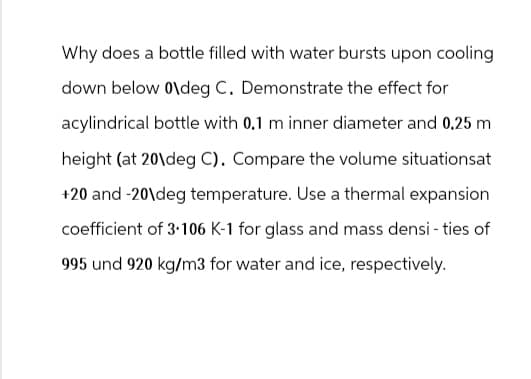Why does a bottle filled with water bursts upon cooling down below 0\deg C. Demonstrate the effect for acylindrical bottle with 0.1 m inner diameter and 0.25 m height (at 20 deg C). Compare the volume situationsat +20 and -20\deg temperature. Use a thermal expansion coefficient of 3.106 K-1 for glass and mass densities of 995 und 920 kg/m3 for water and ice, respectively.
Why does a bottle filled with water bursts upon cooling down below 0\deg C. Demonstrate the effect for acylindrical bottle with 0.1 m inner diameter and 0.25 m height (at 20 deg C). Compare the volume situationsat +20 and -20\deg temperature. Use a thermal expansion coefficient of 3.106 K-1 for glass and mass densities of 995 und 920 kg/m3 for water and ice, respectively.
Engineering Fundamentals: An Introduction to Engineering (MindTap Course List)
5th Edition
ISBN:9781305084766
Author:Saeed Moaveni
Publisher:Saeed Moaveni
Chapter11: Temperature And Temperature- Related Variables In Engineering
Section: Chapter Questions
Problem 10P: Calculate the thermal resistance due to convection for the following situations: a. warm water with...
Related questions
Question

Transcribed Image Text:Why does a bottle filled with water bursts upon cooling
down below 0\deg C. Demonstrate the effect for
acylindrical bottle with 0.1 m inner diameter and 0.25 m
height (at 20 deg C). Compare the volume situationsat
+20 and -20\deg temperature. Use a thermal expansion
coefficient of 3.106 K-1 for glass and mass densities of
995 und 920 kg/m3 for water and ice, respectively.
Expert Solution
This question has been solved!
Explore an expertly crafted, step-by-step solution for a thorough understanding of key concepts.
Step by step
Solved in 2 steps with 3 images

Recommended textbooks for you

Engineering Fundamentals: An Introduction to Engi…
Civil Engineering
ISBN:
9781305084766
Author:
Saeed Moaveni
Publisher:
Cengage Learning

Engineering Fundamentals: An Introduction to Engi…
Civil Engineering
ISBN:
9781305084766
Author:
Saeed Moaveni
Publisher:
Cengage Learning